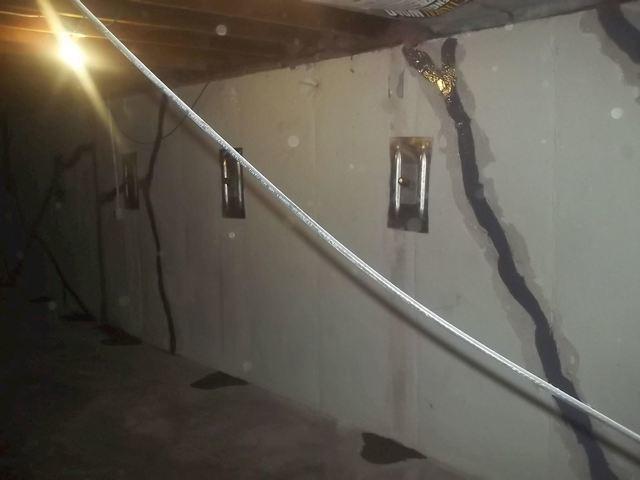Helical Wall Tiebacks Replaced Failing Steel Beams
Challenge
Home Exterior Wall Bowed Inwards, Leaking Significantly, Repaired
Thrasher recommended and installed a permanent foundation repair solution.
This Kansas City homeowner initially called Thrasher for an estimate to repair cracks in the front foundation wall. When our field consultant visited the home, he discovered that the cracks were a symptom of a larger problem. The steel beams installed by another firm were spaced too far apart to handle the wall's load. This improper spacing caused the beams to become overloaded and fail. Previously repaired cracks reappeared and worsened, allowing water to infiltrate the basement.
Thrasher recommended that the existing beams be removed to provide a permanent structural repair solution, and six helical tiebacks be installed to stabilize and straighten the wall.
Thrasher installed a foundation underdrain system to prevent water infiltration. This involved coating the exterior wall with a sealer, applying a drain mat, installing an edge drain and drain tile system, which was extended to a daylight termination point.
Finally, Thrasher epoxy-sealed all cracks.
During excavation, our foundation repair crew discovered an abandoned shallow porch foundation which was pushing on the wall, a significant factor in the inward bowing of the entire wall. Selective demolition of a section of the porch foundation allowed Thrasher to run the tiebacks underneath the abandoned foundation without having to completely remove it. This resulted in a substantial cost savings for the homeowner.
By identifying and addressing the entire scope of the problem rather than proceeding with a quick fix that most likely would have failed, our solution returned this home's foundation to its proper alignment. It ensured that the basement would stay dry.
What are Helical Tiebacks?
Helical anchors/tiebacks are commonly used in tension applications to provide either temporary or permanent lateral or tie-down support for applications including:
- Earth retention systems such as concrete retaining walls, soldier pile and timber lagging, and sheet piling.
- Seismic loading restraint for foundation uplift and lateral support systems.
- Guy anchor support for power lines and communication towers.
- Seawalls and marine bulkhead support.
Helical tiebacks are manufactured with similar helix plate sizes and helix spacing as helical piles installed vertically to support foundation loads. Tiebacks differ from helical piles in that they are typically installed in a horizontal to 45-degree downward from a horizontal orientation to support the tops of earth retaining structures laterally. Helix plates are usually limited to the lead section or the lead and first extension of the tieback. The helix plate design depends on the soil strength parameters and the required working capacity. Multi-helix leads generally consist of increasing plate sizes from the tip. Helical tiebacks may consist of either hollow round shaft or solid square shaft. However, the square is more common due to its socket-and-pin style coupling (quicker and easier to connect) and the ability to penetrate further into the soil with a similar installation torque than a comparably sized round shaft. The end of the shaft is typically coupled to an adaptor that transitions the shaft to the threaded rod.
Both the individual bearing method and the cylindrical shear method are appropriate for determining helical tieback capacity. The torque correlation method is commonly used to verify capacity during tieback installation.
Helical tiebacks are often used to stabilize existing earth retaining structures that have experienced excessive movement, i.e., walls that are cracked, leaning or bowing. The wall distress may result from changes in soil moisture conditions, rise in groundwater levels, plugging of the wall drainage system over time, plumbing leaks, expansive clay soils, frost jacking, or surcharge loads above the wall.
More About Spacing
The minimum center-to-center or horizontal spacing between each tieback is three times the largest helix plate's diameter. For example, if the largest helix plate is 12 inches, the minimum center-to-center spacing is 36 inches. This minimum spacing is required to avoid significant stress overlap within the bearing soils.
The maximum center-to-center spacing is a more complicated question. This assessment must consider the structural details of the wall, reinforcing, present wall condition and the effect of any penetrations necessary to install the tiebacks.
Not to worry, for residential applications, our engineers have created a tool to assist our field consultants to account for all the variables and design a permanent solution.
For commercial applications, our staff engineers will review each project with our field consultants to achieve the required outcome. While most commercial clients also need permanent solutions, in some cases, temporary solutions are needed, such as when excavation protection is necessary for the safety of personnel and underpinning of existing structures. We treat temporary installations with the same level of analysis and design as permanent installations.
Thrasher Difference
All of our steel products are engineered and manufactured with exacting standards. Our helix plates are true helices, meaning that the plates are designed to follow exactly after the plate's leading edge to "screw" into the bearing soils as opposed to boring through the ground the way a "split washer" plate would.

